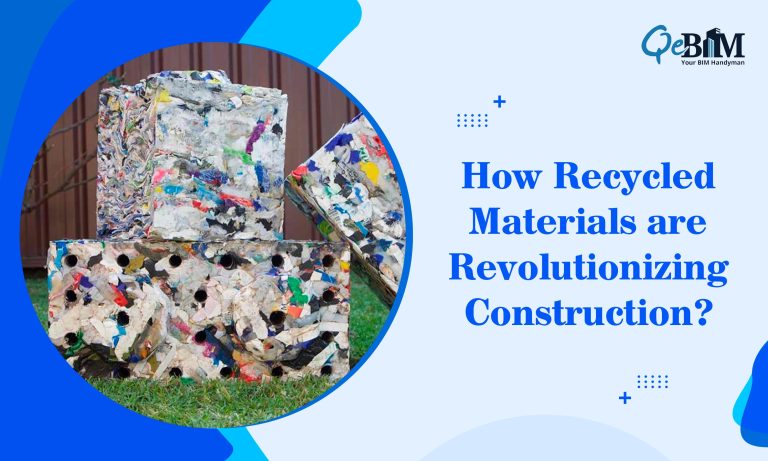How Recycled Materials are Revolutionizing Construction?

Considering today’s era where environmental concerns dominate the global discussions, the construction industry stands at a crossroads. The traditional building practices are often linked to significant resource depletion as well as waste. This calls for more sustainable alternatives like the use of recycled materials in the construction practices. Using recycled materials not only mitigates the environmental impact but also addresses to some of the most urgent challenges of the industry.
The Environmental Imperative
The construction sector accounts for a significant share of global resource use and waste generation. The United Nations Environment Programme reports that buildings are responsible for about 40% of global energy consumption and 30% of greenhouse gas emissions.
Traditional construction materials like concrete and steel were quite resource-intensive to produce and contribute to the environmental degradation. As we grapple with the climate change and resource scarcity, the need to adopt more sustainable practices has never been clearer.
Recycling construction materials presents a promising way to lessen environmental impacts. By repurposing the existing resources, we can decrease the demand for virgin materials, lower the energy consumption as well as minimize the wastage. This not only helps to conserve the natural resources but also reduces the greenhouse gas emissions that are associated with the material production as well as the transportation.
Types of Recycled Materials in Construction
- Recycled Concrete Aggregates (RCA): RCA is among the most commonly utilized recycled materials. It is derived from the crushed concrete from the demolished structures. It can be used as a substitute for natural aggregates in new concrete thereby reducing the need for quarrying. Studies have shown that RCA can be as effective as traditional aggregates when properly processed ultimately making it a viable option for sustainable construction.
- Recycled Steel: Steel is also among the most recyclable materials used in the construction industry. Recycled steel retains the same quality and strength as new steel. It can also be used in structural frameworks, roofing, and more. The recycling process significantly reduces the energy consumption compared to the producing new steel, which is beneficial for both the environment as well as the economy.
- Reclaimed Wood: Wood reclaimed from old buildings, bridges and even demolished furniture can be repurposed for new construction projects. Reclaimed wood often possesses unique aesthetic qualities along with the historical value. This makes it a highly demanded material for high-end and custom projects. Additionally, reusing the wood helps to preserve forests and reduce deforestation.
- Glass: Recycled glass can be transformed into various construction materials including tiles, insulation, and countertops. This material is not only visually striking but also durable and versatile. The recycling process for glass consumes less energy than producing a new glass ultimately making it a sustainable choice for the construction.
- Recycled Plastic: Plastic waste including bottles and packaging can be transformed into building materials such as bricks, tiles as well as insulation panels. These materials are lightweight, durable and even resistant to the weather conditions therefore are apt for sustainable construction.
Benefits of Using Recycled Materials
- Environmental Impact: The primary advantage of using recycled materials is the reduction in environmental impact. Recycling helps cut down the demand for new raw materials, minimizes landfill waste, and lowers greenhouse gas emissions linked to production and transportation.
- Cost Efficiency: Recycled materials are often more cost-effective than their virgin counterparts. This cost-saving potential can be particularly advantageous in the large-scale construction projects where material costs can constitute to a significant portion of the budget.
- Innovation and Aesthetics: Recycled materials offer unique aesthetic possibilities as well as the design innovations. Architects and builders can experiment with the different textures, colours and finishes thereby creating a distinctive yet visually appealing structures that stand out in the marketplace.
- Regulatory Compliance: Many regions have implemented regulations and incentives to promote the use of recycled materials in construction. By incorporating these materials, builders and developers can often benefit from tax breaks, grants or other forms of support, while also demonstrating their commitment to the sustainability.
Challenges and Considerations
Despite the benefits, using recycled materials in construction comes up with its own challenges The quality and consistency of recycled materials can vary, necessitating thorough testing and stringent quality control. Additionally, the availability of certain recycled materials may be limited depending on the local recycling infrastructure and supply chains.
To overcome these challenges, it is important to invest in the advanced recycling technologies and infrastructure. It is also wise to opt of precise BIM Services to foster collaboration between stakeholders in the construction and the recycling industries. By working together, we can address the quality concerns, improve the supply chain efficiency as well as promote wider adoption of the recycled materials.
The Path Forward
The future of construction lies in embracing the 6D BIM Services that focuses on sustainability and recycled materials. As recycling practices become more refined, the potential for recycled materials to transform the industry will only grow.
Builders, architects, and developers must continue to explore the benefits of recycled materials to create environmentally responsible and economically viable solutions.
In conclusion, the recycled materials offer a sustainable approach to the building construction that aligns well with the global environmental goals as well as the economic realities. By incorporating these materials into our construction practices, we can pave the way for a more sustainable future, reducing waste, conserving resources and ultimately building a greener world for the generations to come.